Unresectable Hepatocellular Carcinoma Market Size
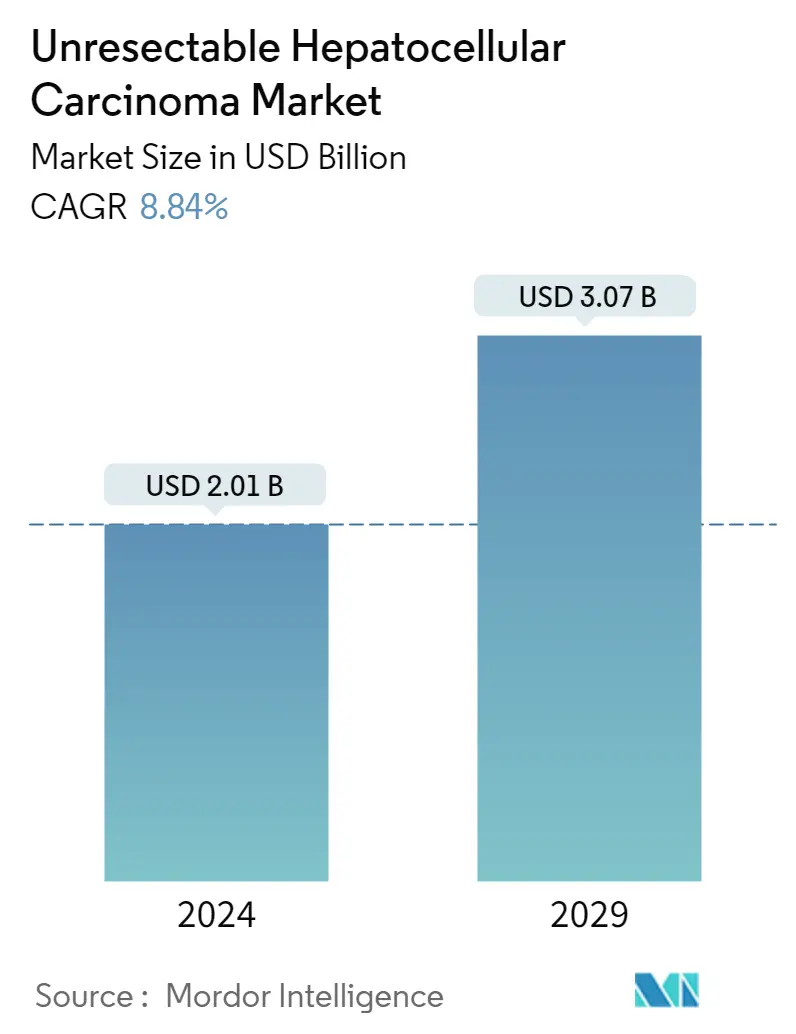
| Study Period | 2019 - 2029 |
| Market Size (2024) | USD 2.01 Billion |
| Market Size (2029) | USD 3.07 Billion |
| CAGR (2024 - 2029) | 8.84 % |
| Fastest Growing Market | Asia Pacific |
| Largest Market | North America |
Major Players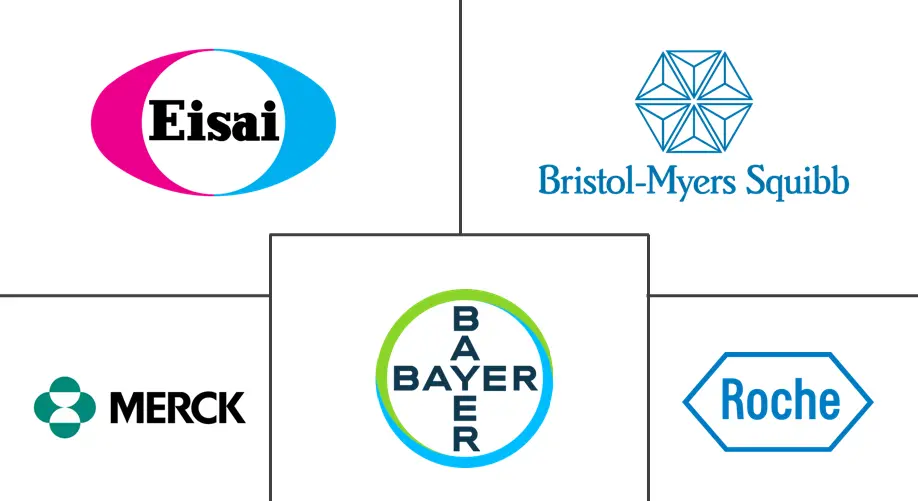
*Disclaimer: Major Players sorted in no particular order |
Unresectable Hepatocellular Carcinoma Market Analysis
The Unresectable Hepatocellular Carcinoma Market size is estimated at USD 2.01 billion in 2024, and is expected to reach USD 3.07 billion by 2029, growing at a CAGR of 8.84% during the forecast period (2024-2029).
The COVID-19 pandemic has significantly impacted the unresectable hepatocellular carcinoma market. As per a research study titled "Impacts of COVID-19 on Liver Cancers: During and after the Pandemic", published in the National Library of Medicine in May 2020, hepatocellular carcinoma (HCC) patients are more vulnerable to the effects of COVID-19 than other cancer patients as the hepatic injury caused by SARS-CoV-2 could complicate the existing hepatitis virus infection and cirrhosis. Further, barriers to accessing cancer drugs during the COVID-19 pandemic endangered the stability and integrity of pharmaceutical supply chains, thus limiting the supply of drugs across healthcare facilities. Thus, the COVID-19 pandemic has altered healthcare priorities, which may adversely impact HCC management.
The major factors fueling the market's growth are the high incidence rate of liver carcinoma and the advancement in new treatment options.
The high incidence rate of liver carcinoma is a major factor driving the market's growth. According to a September 2021 update by the Centers for Disease Control and Prevention, each year, about 24,500 men and 10,000 women in the United States get liver cancer, and about 18,600 men and 9,000 women die from the disease. As per the statistics, there is a significant rise in the patient pool, which is expected to boost the market's growth. Additionally, according to GLOBOCAN 2020, the estimated number of new liver cancer cases worldwide in 2020 was 906,000, and the number is expected to reach 1.40 million by 2040. Thus, the increasing incidence rate of liver cancer reflects the growing rate of unresectable hepatocellular carcinoma, which is augmenting the demand for unresectable HCC treatment.
Moreover, advancements in new treatment options are boosting the market's growth. For instance, according to an article published in Karger Journal, in 2021, various phase 3 trials reported a clinical benefit for the tyrosine kinase inhibitors lenvatinib, regorafenib, and cabozantinib in HCC. Additionally, as per a 2022 update by The Reagents of the University of California, 51 clinical trials are in progress for hepatocellular carcinoma treatment. As per an October 2021 published article titled "Hepatic Arterial Infusion Chemotherapy Is a Feasible Treatment Option for Hepatocellular Carcinoma: A New Update", hepatic arterial infusion chemotherapy (HAIC) has greater survival in patients with advanced HCC. Thus, the availability of advanced drugs in the treatment of hepatocellular carcinoma is expected to boost the market over the forecast period.
However, fewer diagnoses and poor efficacy of current therapeutic agents are major factors restraining the market's growth.
Unresectable Hepatocellular Carcinoma Market Trends
This section covers the major market trends shaping the Unresectable Hepatocellular Carcinoma Market according to our research experts:
Chemotherapy Holds Significant Share in the Unresectable Hepatocellular Carcinoma Market
By treatment, the chemotherapy segment is expected to witness significant growth. The major factors fueling the segment's growth are the increasing prevalence of hepatocellular carcinoma, the growing number of drug approvals, and advancements in new treatment options.
For instance, as per a 2021 update by the American Society of Clinical Oncology (ASCO), chemoembolization is a type of chemotherapy treatment similar to hepatic arterial infusion. The same source also reported that drugs are injected into the hepatic artery during this procedure, and the flow of blood through the artery is blocked for a short time. Thus, the chemotherapy stays in the tumor for a longer period, making chemotherapy treatment more effective. Therefore, such factors are boosting the adoption of chemotherapy as a better treatment option for patients suffering from HCC, thereby contributing to the segment's growth.
Furthermore, a news article published in February 2022 detailed a study conducted at Tianjin Cancer Hospital in China. The researchers examined 35 patients with intermediate/advanced HCC at Tianjin Cancer Hospital. The study concluded that in patients with unresectable hepatocellular carcinoma (HCC), the most frequent kind of primary liver cancer, combining PD-1 immune checkpoint suppression with transarterial chemotherapy and Lenvima (lenvatinib) improved prognosis. Such factors increase the adoption of chemotherapy among the patient population, thus driving the segment's growth.
Thus, the factors mentioned above are anticipated to boost the segment's growth over the forecast period.
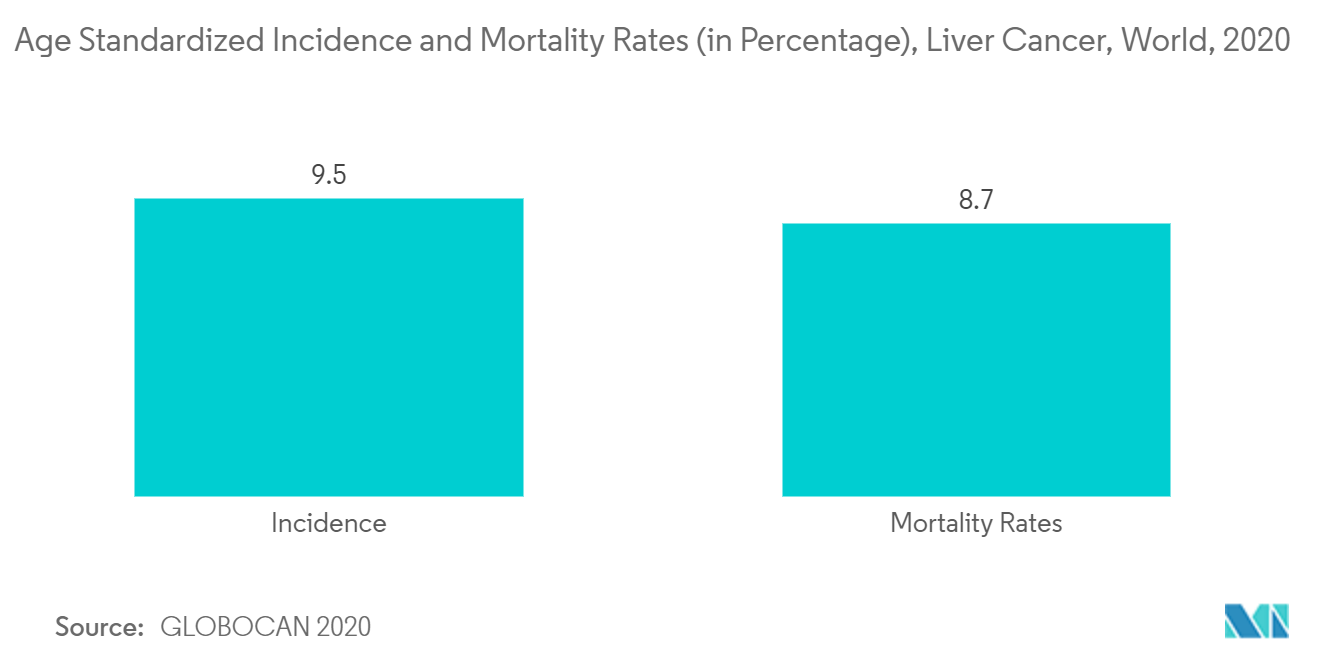
North America Dominates the Unresectable Hepatocellular Carcinoma Market
Within North America, the United States holds the major share of the market. Factors such as the increasing prevalence of liver cancer in the country, technological advancements in drug development, increasing R&D investments, and the growing geriatric population are expected to drive the US unresectable hepatocellular carcinoma market during the forecast period. According to data by GLOBOCAN 2020, the estimated number of liver and intrahepatic bile duct cancer cases in the country was 42,284 in 2020. The number is expected to reach 52,703 by 2040. Unresectable hepatocellular carcinoma is the most common type of liver cancer. The expected increase in cancer cases in the country may drive the market's growth.
Several market players are engaged in implementing strategic initiatives, thereby contributing to the market's growth. For instance, in February 2022, Eureka Therapeutics Inc., a clinical-stage biotechnology company developing novel T-cell therapies to treat solid tumors, reported that the US Food and Drug Administration (FDA) granted Orphan Drug Designation (ODD) to ET140203 and ECT204 for the treatment of hepatocellular carcinoma (HCC), the most common form of liver cancer. In January 2020, AstraZeneca's durvalumab (Imfinzi) and tremelimumab were granted the US FDA Orphan Drug Designation to treat hepatocellular carcinoma (HCC).
Thus, due to the above-mentioned factors, the market is expected to grow significantly in the region over the forecast period.
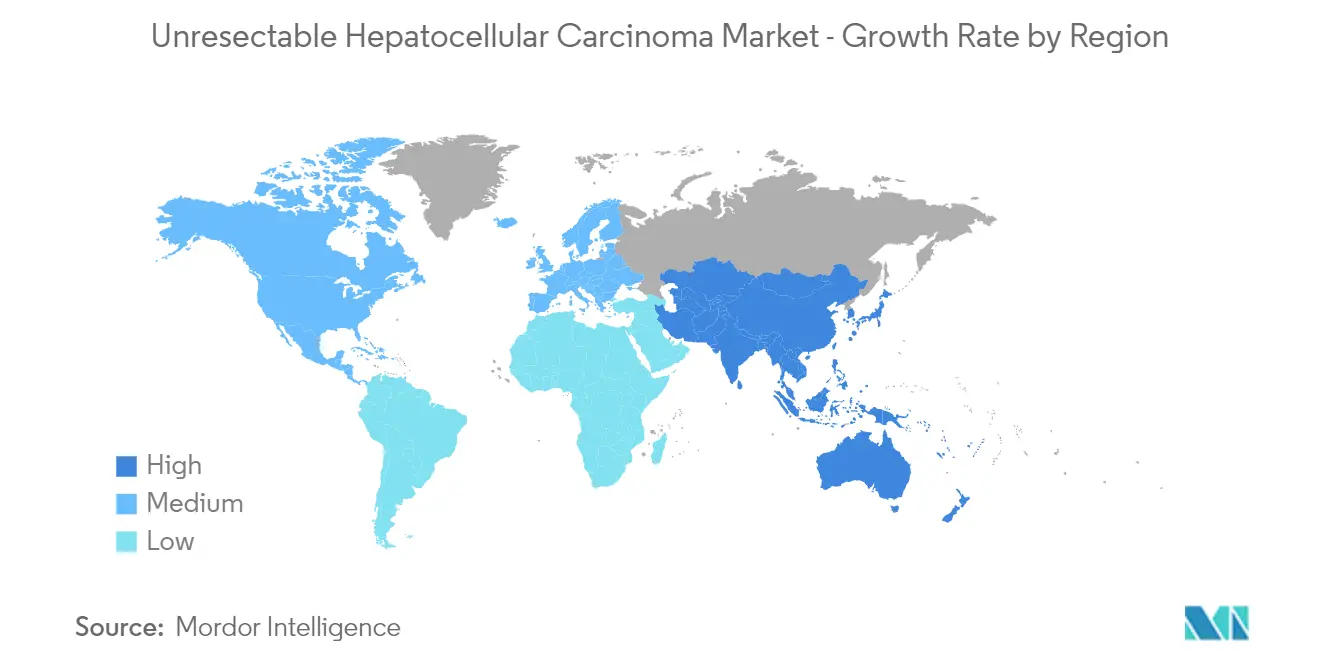
Unresectable Hepatocellular Carcinoma Industry Overview
The unresectable hepatocellular carcinoma market is moderately competitive and consists of a few major players. Companies like AstraZeneca PLC, Bayer AG, Bristol-Myers Squibb Company, Celgene Corporation, Eisai Co. Ltd, F. Hoffmann-La Roche Ltd, Merck & Co. Inc., and Pfizer Inc. hold a substantial market share.
Unresectable Hepatocellular Carcinoma Market Leaders
-
Bristol-Myers Squibb Company
-
Bayer AG
-
F. Hoffmann-La Roche Ltd
-
Eisai Co. Ltd
-
Merck & Co. Inc.
*Disclaimer: Major Players sorted in no particular order
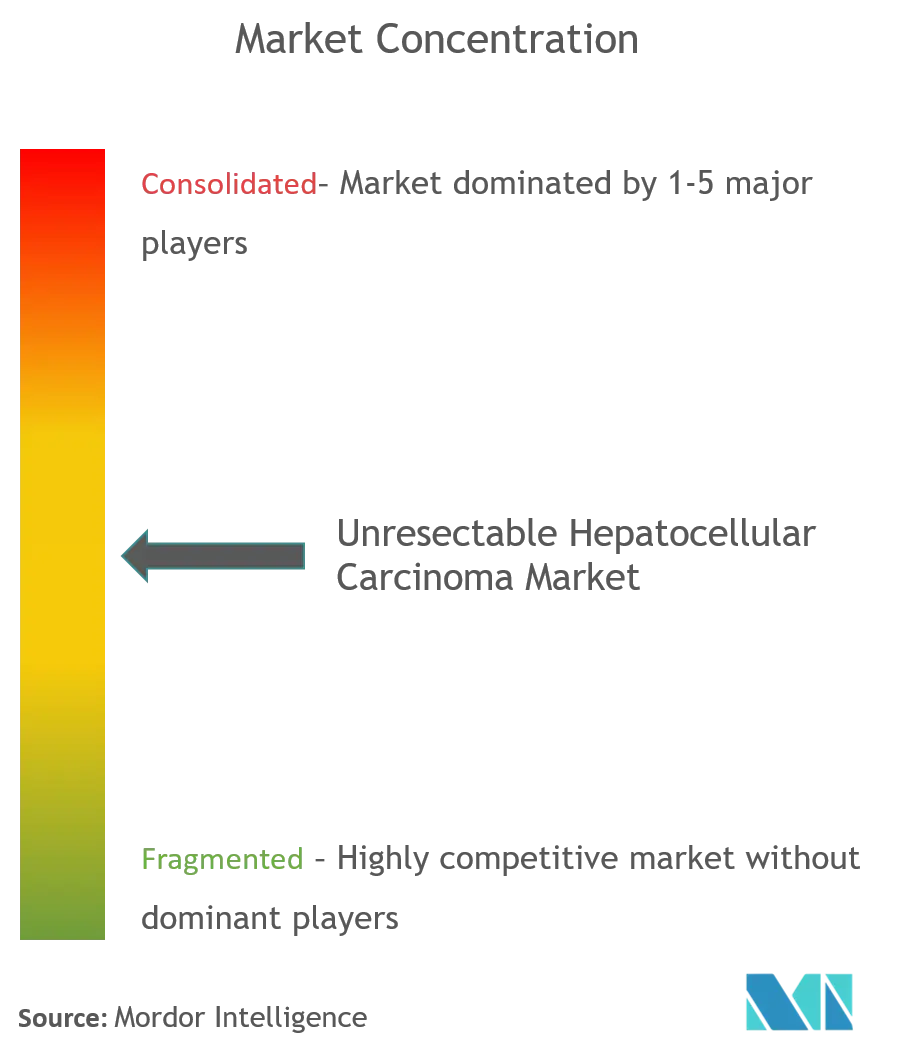
Unresectable Hepatocellular Carcinoma Market News
In November 2021, Elevar Therapeutics Inc., a fully integrated biopharmaceutical company built on the promise of elevating treatment experiences and outcomes for patients with limited or inadequate therapeutic options, reported that the US FDA granted rivoceranib with Orphan Drug Designation (ODD) for the treatment of hepatocellular carcinoma (HCC).
In October 2021, AstraZeneca revealed that its product Imfinzi plus tremelimumab significantly improved the overall survival rate in HIMALAYA Phase III trial in 1st-line unresectable liver cancer.
Unresectable Hepatocellular Carcinoma Market Report - Table of Contents
1. INTRODUCTION
- 1.1 Study Deliverables
- 1.2 Study Assumptions
- 1.3 Scope of the Study
2. RESEARCH METHODOLOGY
3. EXECUTIVE SUMMARY
4. MARKET DYNAMICS
- 4.1 Market Overview
-
4.2 Market Drivers
- 4.2.1 High Incidence Rate of Liver Carcinoma
- 4.2.2 Advancement in New Treatment Options
-
4.3 Market Restraints
- 4.3.1 Less Diagnosis and Poor Efficacy of Current Therapeutic Agents
-
4.4 Porter's Five Forces Analysis
- 4.4.1 Threat of New Entrants
- 4.4.2 Bargaining Power of Buyers/Consumers
- 4.4.3 Bargaining Power of Suppliers
- 4.4.4 Threat of Substitute Products
- 4.4.5 Intensity of Competitive Rivalry
5. MARKET SEGMENTATION (Market Size by Value - USD million)
-
5.1 By Treatment
- 5.1.1 Chemotherapy
- 5.1.2 Molecularly Targeted Therapy
- 5.1.3 Immunotherapy
- 5.1.4 Other Treatments
-
5.2 By End User
- 5.2.1 Hospitals
- 5.2.2 Cancer Centers
- 5.2.3 Other End Users
-
5.3 By Geography
- 5.3.1 North America
- 5.3.1.1 United States
- 5.3.1.2 Canada
- 5.3.1.3 Mexico
- 5.3.2 Europe
- 5.3.2.1 Germany
- 5.3.2.2 United Kingdom
- 5.3.2.3 France
- 5.3.2.4 Italy
- 5.3.2.5 Spain
- 5.3.2.6 Rest of Europe
- 5.3.3 Asia-Pacific
- 5.3.3.1 China
- 5.3.3.2 Japan
- 5.3.3.3 India
- 5.3.3.4 Australia
- 5.3.3.5 South Korea
- 5.3.3.6 Rest of Asia-Pacific
- 5.3.4 Middle-East and Africa
- 5.3.4.1 GCC
- 5.3.4.2 South Africa
- 5.3.4.3 Rest of Middle-East and Africa
- 5.3.5 South America
- 5.3.5.1 Brazil
- 5.3.5.2 Argentina
- 5.3.5.3 Rest of South America
6. COMPETITIVE LANDSCAPE
-
6.1 Company Profiles
- 6.1.1 Astrazeneca PLC
- 6.1.2 Bayer AG
- 6.1.3 Bristol-Myers-Squibb Company
- 6.1.4 Celgene Corporation
- 6.1.5 Eisai Co. Ltd
- 6.1.6 F. Hoffmann-La Roche Ltd
- 6.1.7 Merck & Co. Inc.
- 6.1.8 Pfizer Inc.
- 6.1.9 Chugai Pharmaceutical Co. Ltd
- 6.1.10 Pharmaxis
- 6.1.11 Eli Lilly
- 6.1.12 BeiGene
- *List Not Exhaustive
7. MARKET OPPORTUNITIES AND FUTURE TRENDS
** Subject To AvailablityUnresectable Hepatocellular Carcinoma Industry Segmentation
As per the scope of the report, unresectable hepatocellular carcinoma is defined as a type of liver tumor not eligible for resection therapy given the extent of the disease, including patients that were not suitable for surgery for the location of the tumor(s) in the liver, those who were older than 75 years, or those who refused surgical therapies. The market is segmented by treatment, end user, and geography. The market report also covers the estimated market sizes and trends for 17 countries across major regions globally. The report offers the value in USD million for the above segments.
| By Treatment | Chemotherapy | |
| Molecularly Targeted Therapy | ||
| Immunotherapy | ||
| Other Treatments | ||
| By End User | Hospitals | |
| Cancer Centers | ||
| Other End Users | ||
| By Geography | North America | United States |
| Canada | ||
| Mexico | ||
| By Geography | Europe | Germany |
| United Kingdom | ||
| France | ||
| Italy | ||
| Spain | ||
| Rest of Europe | ||
| By Geography | Asia-Pacific | China |
| Japan | ||
| India | ||
| Australia | ||
| South Korea | ||
| Rest of Asia-Pacific | ||
| By Geography | Middle-East and Africa | GCC |
| South Africa | ||
| Rest of Middle-East and Africa | ||
| By Geography | South America | Brazil |
| Argentina | ||
| Rest of South America |
Unresectable Hepatocellular Carcinoma Market Research FAQs
How big is the Unresectable Hepatocellular Carcinoma Market?
The Unresectable Hepatocellular Carcinoma Market size is expected to reach USD 2.01 billion in 2024 and grow at a CAGR of 8.84% to reach USD 3.07 billion by 2029.
What is the current Unresectable Hepatocellular Carcinoma Market size?
In 2024, the Unresectable Hepatocellular Carcinoma Market size is expected to reach USD 2.01 billion.
Who are the key players in Unresectable Hepatocellular Carcinoma Market?
Bristol-Myers Squibb Company , Bayer AG, F. Hoffmann-La Roche Ltd, Eisai Co. Ltd and Merck & Co. Inc. are the major companies operating in the Unresectable Hepatocellular Carcinoma Market.
Which is the fastest growing region in Unresectable Hepatocellular Carcinoma Market?
Asia Pacific is estimated to grow at the highest CAGR over the forecast period (2024-2029).
Which region has the biggest share in Unresectable Hepatocellular Carcinoma Market?
In 2024, the North America accounts for the largest market share in Unresectable Hepatocellular Carcinoma Market.
What years does this Unresectable Hepatocellular Carcinoma Market cover, and what was the market size in 2023?
In 2023, the Unresectable Hepatocellular Carcinoma Market size was estimated at USD 1.85 billion. The report covers the Unresectable Hepatocellular Carcinoma Market historical market size for years: 2019, 2020, 2021, 2022 and 2023. The report also forecasts the Unresectable Hepatocellular Carcinoma Market size for years: 2024, 2025, 2026, 2027, 2028 and 2029.
Unresectable Hepatocellular Carcinoma Industry Report
Statistics for the 2023 Unresectable Hepatocellular Carcinoma market share, size and revenue growth rate, created by Mordor Intelligence™ Industry Reports. Unresectable Hepatocellular Carcinoma analysis includes a market forecast outlook to 2029 and historical overview. Get a sample of this industry analysis as a free report PDF download.



